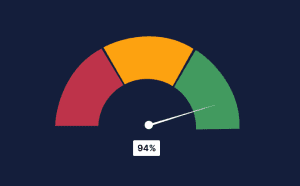What Are The Four Types Of Benchmarking?

In today’s everchanging climate, it’s important for businesses to conduct industry and competitor analysis to better understand their position in a specific market. That’s why so many companies use competitor benchmarking analysis. Not only can it help identify ways your business could make improvements, but it also helps to establish what your competitors are doing to achieve success.
If you’re interested in finding out more about the four different types of benchmarking and examples, as well as the pros and cons of using this type of analysis, check out our blog below for all the details…
What is benchmarking?
Benchmarking is a process businesses undertake to better understand how their performance compares to their competitors or industry standards. It involves identifying key practices by collecting relevant data and drawing conclusions from the results presented. This approach helps a business to establish goals to keep up with competitors or current industry standards.
To meet these goals, they might implement new ways of working, such as internal processes that have proven to be effective with their competitors, or refining a product/service to make it more appealing. Overall, benchmarking helps businesses to boost improvement and innovation in an everchanging market.
The four different types of benchmarking
Now you know what benchmarking is, it’s important to understand the different types – so you can understand what process your company should use. The four main types include:
Internal benchmarking
Internal benchmarking refers to the process of comparing performance, processes, and best practices within different departments, offices, or regions of the same organisation. For this to work, the company will have to have various locations where data can be collated.
Example: A restaurant chain is interested in seeing why one location gets more footfall than the other. To evaluate this, they’ll compare specific metrics of both locations to see how they can improve the location with less footfall.
Competitive benchmarking
Competitive or external benchmarking is when a business looks at certain data from a competitor to understand how they can better their own model and internal/external practices.
Example: A popular phone brand (think Apple) wants to understand why another company (maybe Samsung) has better levels of customer satisfaction. To gain this knowledge, they might gather data from product reviews and customer feedback.
Functional benchmarking
Functional benchmarking focuses on specific departments and how they operate within a competitor company.
Example: The marketing department in a law firm wants to understand why a competitor’s marketing is attracting more clientele. To understand this, they might look at data from website traffic and conversion rates.
Generic benchmarking
Generic benchmarking is the overall analysis of a successful business. In this type of benchmarking, companies will look at successful businesses in other industries to get a better understanding of their achievements and efficiency.
Example: A healthcare business adopts the practices of a leading airline to understand how they can keep service users happy and satisfied.
Why do companies use benchmarking?
Benchmarking can be an extremely useful competitor analysis process, providing businesses that perform it with several advantages, including:
Identifies best practices
One of the reasons why companies use benchmarking is to identify best practices. This might be the best practices of their competitors or in comparison to the existing industry standard. For example, they might initially consider key performance indicators (such as footfall at a trade event or overall conversion rates).
Once this data has been identified and collated from internal and external resources, a company can analyse how its competitor has achieved this result and pinpoint ways they can enhance their own business through this level of evaluation. Ultimately, a business can replicate and implement these processes in its own company to improve its overall model and operations.
Better understanding of competitors
As mentioned, benchmarking is a form of competitor analysis, so it makes sense that performing it gives businesses a better understanding of their competitors. In a world that’s rapidly evolving every day, businesses need to be aware of how they are paling in comparison to their competitors.
As benchmarking offers the ability to compare and contrast competitor data, companies can establish what these competitors are doing differently/better, and identify ways they can do so too. As a result, they can stay ahead of the curve and continue to position themselves as an industry leader.
Improves performance
As benchmarking is a form of self and competitor evaluation, it means you’re able to identify the strengths and weaknesses of your business and your competitors. As such, you’re able to confirm gaps in your operations and be influenced by ways to improve from the successes of your competitors.
Ultimately, this can help to improve your overall business performance and other key metrics, as it gives you the opportunity to establish where the drawbacks in your companies lie, as well as determine ways to improve these challenges.
What are the common challenges of benchmarking?
Like any type of competitor analysis, there are bound to be drawbacks and potential challenges your company encounters when conducting benchmarking. For example:
Issues with data accessibility
Possibly the biggest challenge in benchmarking is collating your data and the accessibility you’ll have to certain types of data. Proprietary information can be hard to come by, as no business wants to have its industry secrets revealed to competitors.
Meanwhile, data regulations prohibit access to sensitive data, so it can be hard to obtain the information you need to draw accurate comparisons.
Different business models and practices
Another challenge you might encounter when conducting the benchmarking process is that there are an unlimited amount of varied business models and practices. This might seem obvious, but this variation might make it more difficult for you to accurately benchmark and come to specific conclusions.
This can pose a problem as these conclusions will influence your plan of action post-benchmarking, and inaccurate findings can create the wrong practice/model implementations.
Imitation over improvement
You might also struggle with the difference between imitation and improvement when benchmarking. In simple terms, benchmarking is there to offer an indication of how some components in your competitor’s business process could improve your own operations. But this doesn’t mean you should copy it exactly, and doing so can result in poor imitations of your competitors.
Ensure you focus on improving your company and not replicating your competitors in their entirety. Remember, your business is established and evolving for a reason – because it offers something different. Keep that in mind when you create your post-benchmarking plan of action!
Evolve your business with a free benchmarking demo from Exposure Analytics
It’s easy to celebrate your wins, but identifying your business’s drawbacks can be a difficult task – especially when you’re so close to its everyday operations. Fortunately for you, Exposure Analytics is here to help.
If you’re seeking an in-depth analysis of how your performance compares to your industry competitors, get in touch with Exposure Analytics today at 0203 982 0997 to book your free demo. With our competitive benchmarking software, our experts can help your business exceed its objectives and make noise in your market.
Types of benchmarking: FAQs
What are some benchmarking tools?
To ensure the benchmarking you perform collects accurate data, you need to acquire the best tools to do so. There are a variety of benchmarking apps and websites you can use, including the services at Exposure Analytics. For example, we offer the following:
- Booth scoring: Using unique event tracking sensor technology, we can help businesses at trade and exhibition shows get the most out of these events from our booth scoring service. See how your booth compares to competitors in terms of footfall and interaction with this type of accurate benchmarking data.
- Insights dashboard: You can better understand your event performance with our insights dashboard. Using smart sensors that we install in your exhibition booth, you can collate critical insights into your customer’s behaviour.
- KPIs: Monitor your KPIs with Exposure Analytics KPI tracking software. You can gain instant access to data from live events to help you optimise your ROI. Plus, you can customise your metrics based on your very own goals. After all, no business is the same, so your objectives won’t be either.
You can find out more about our services here, or book a free demo today.
What is the key to solid benchmarking?
It might sound simplistic, but the key to solid, successful benchmarking is to ensure you have planned accordingly and prepared as much as possible. This means identifying relevant objectives and determining how you evaluate your data in accordance with this. Use the following tips to guide you in your benchmarking process:
- Identify relevant metrics: Ensure you pick the right metrics to benchmark against. Choose ones that align with your goals and can provide an insight into where you can improve, and what’s already working well.
- Make fair comparisons: No business is the same, so the comparisons you make need to be fair to be accurate. Ensure you’re drawing comparisons based on the same performance indicators (e.g. cost efficiency), and that the competitors you are analysing are of the same size, industry, and environment.
- Recognise that benchmarking is ongoing: Finally, ensure you’re aware that benchmarking is an ongoing process. You aren’t going to see results overnight, and you need to continuously analyse and identify areas of improvement throughout each year – otherwise, your company could fall behind.


